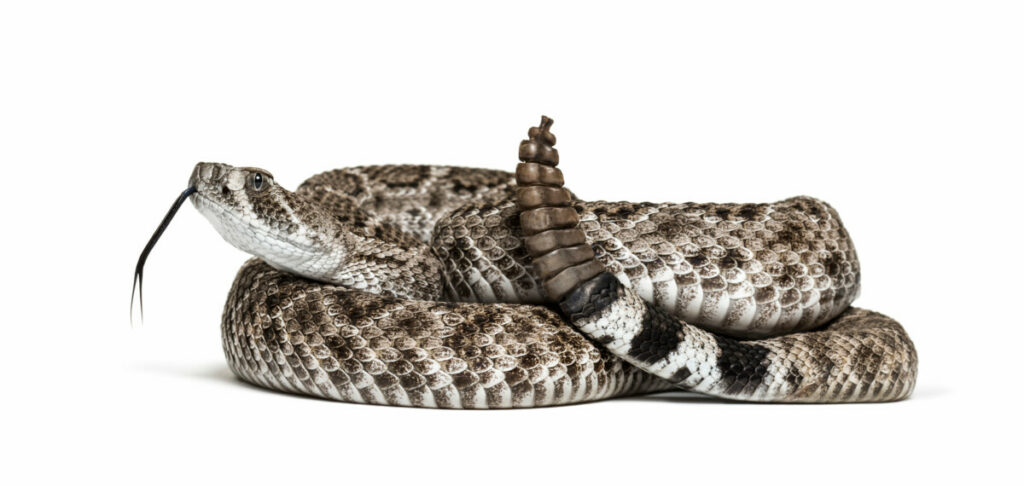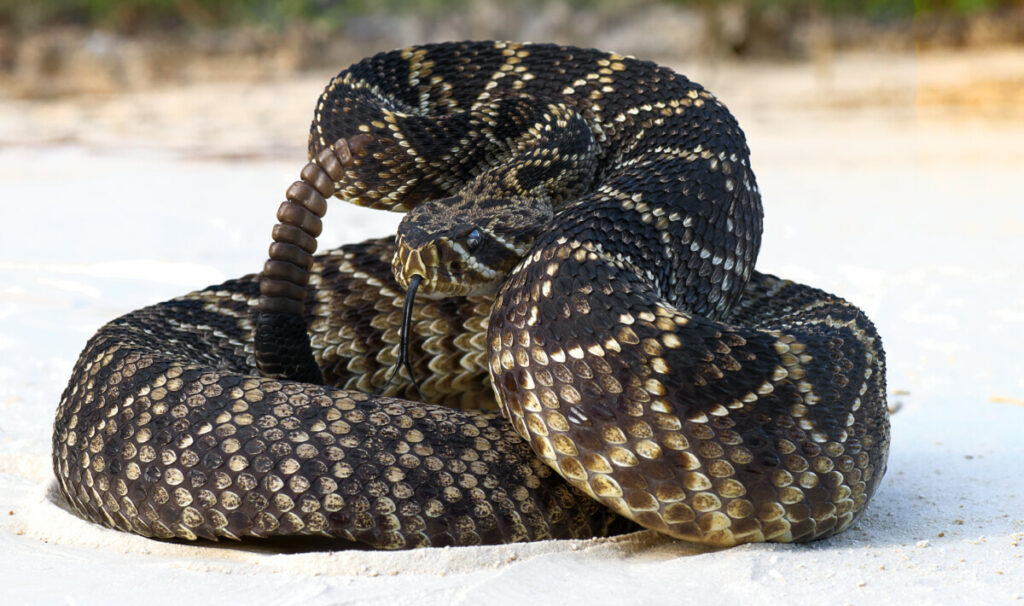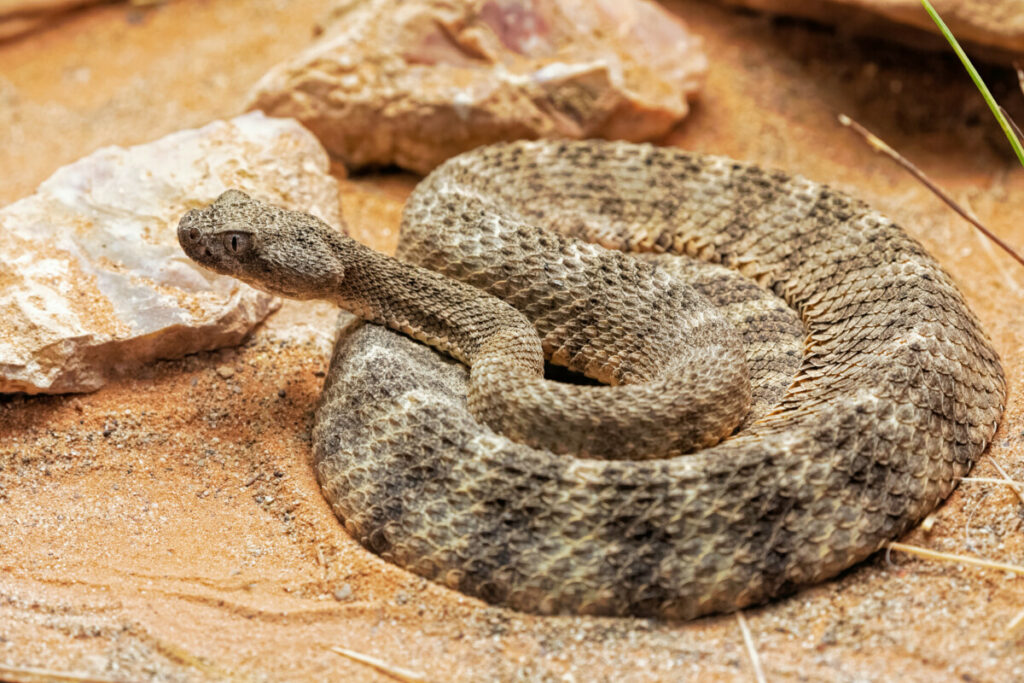
If you live in the United States, there is a good chance that you have seen at least one rattlesnake in your life. Rattlesnakes are spread around many of the lower 48 states and are frequently portrayed in movies and tv shows. With their trademark rattle and fangs, people often wonder: how venomous are rattlesnakes?
Rattlesnakes are a group of venomous snakes whose venom can be fatal to pets and humans. The strength of venom varies between species, but common effects of the venom include the destruction of body tissue and organs and neurological damage. Untreated bites will lead to permanent damage or death.
While rattlesnake bites are dangerous, as long as you receive the proper medical treatment there is a low likelihood of the bite leading to the victim’s death.
How Powerful Is Rattlesnake Venom?
There are around 40 different types of rattlesnakes, all of them found in North and South America. All these different types of rattlesnakes and their subspecies are venomous. Using their fangs, they inject prey and predator alike with their venom.
Because they use their fangs, rattlesnakes are venomous, not poisonous, as rattlesnakes use their fangs to inject venom into their target’s body instead of poison being introduced into the mouth and stomach of the target. While we know that rattlesnakes are venomous, how powerful is their venom?
There are a couple of things that we need to consider when talking about rattlesnake venom. The first thing that we should consider is the amount of venom that is transferred during a rattlesnake bite. Not every rattlesnake bite will be accompanied by venom.
The rattlesnake uses the venom to hunt prey, so if it doesn’t view you as prey, it may bite you without injecting you with venom. One idea that is floated around is that 1 in 5 rattlesnake bites will occur without venom, and it could be as high as 1 in 4.
Some Rattlesnakes Inject More Venom Than Others
On the other hand, what happens if the rattlesnake does use venom as part of its bite? Some species of rattlesnakes tend to use more venom per bite, while others are more conservative.
Types of rattlesnake that are known for being liberal with their venom are the Timber Rattlesnake, and the Diamond Rattlesnake, both the Western and Eastern varieties.
The next thing to consider is the size of the victim. Children and pets are at the biggest risk from rattlesnake venom. Remember, rattlesnake venom is intended to be used on prey like lizards and mice. It is not powerful enough to cause immediate damage to larger animals and people.
However, the venom will linger in the body and will begin to cause more serious damage over time. Children, pets, and adults in poor health will experience this damage the quickest.
Healthy adults typically have a day or two after being bitten by a rattlesnake before their life is in danger, although you shouldn’t wait that long to go to the hospital if you are bitten by a rattlesnake. If bitten by a venomous snake you need to seek medical help ASAP.
While rattlesnake venom is not powerful enough to kill you immediately, it can kill you over time or cause serious damage if you do not receive medical attention.
What Is the Most Venomous Type of Rattlesnake?

There are several different species of rattlesnake found throughout the United States. Some species may be found further south or to the north, but the majority of species are concentrated in the U.S.
Arizona alone has more species of rattlesnake than any other state with 13 species alone. All of these snakes are venomous, but which one is the most venomous? Which of these rattlesnakes are the most dangerous to you?
The most venomous types of rattlesnakes are the Diamondback rattlesnake, both varieties, and the Mojave rattlesnake. These rattlesnakes not only use dangerous venom, but they are not afraid of using it on humans.
The diamondback rattlesnake with the western and eastern species between them causes the most deaths of any venomous snake in the United States.
When they bite they inject a large amount of venom into their victims. They are larger than many other types of rattlesnakes, with the Eastern Diamondback being the largest species of rattlesnake.
The other dangerous rattlesnake is the Mojave rattlesnake whose venom is accompanied by a high amount of neurotoxins.
Bites from the Mojave are often accompanied by numbness in the limbs, trouble breathing, and temporary blindness in some cases.
While it isn’t good to be bitten by a rattlesnake, you definitely don’t want to be bitten by one of these most venomous types of the rattlesnake.
What Kind Of Venom Do Rattlesnakes Have?
Rattlesnake venom contains both hemotoxins and neurotoxins. That said, it contians mostly hemotoxins. While hemotoxins can cause damage to the human body, they aren’t a quick-acting type of venom.
All rattlesnakes share a basic type of venom. Their venom serves two purposes. The first is the weakening, slowing the movement of, and paralyzing of the victims of their bites.
Initially, the venom will stop their prey from escaping. However, as the venom spreads throughout their body, the venom begins to break down the tissue in their body.
The rattlesnakes wait for this venom to spread, before swallowing their prey whole. Since rattlesnakes take a long time to digest their prey once it has been swallowed, the venom helps to speed up the process.
Venom Helps Break Down The Rattlesnakes Prey
Depending on the size of the rattlesnake, it could take weeks for them to digest a meal. During this time the snake will be sluggish and unable to predators.
Hence the second role of the venom is the help the rattlesnake finish their meal quickly.
Since rattlesnake venom is intended to be used on prey like small mice and lizards, it doesn’t have an immediate effect on humans.
Because of our size, it takes time for the venom to begin causing damage and breaking your body down. Generally, as long as you receive medical treatment within an hour or two of being bitten you can avoid the worst effects of the hemotoxins.
The bigger danger of rattlesnake venom is any neurotoxins that may be part of the venom. Some species of rattlesnakes naturally produce these neurotoxins. Others have begun to adapt in recent years to use them.
These neurotoxins can cause damage to your nerves and can shut down a victim’s respiratory system. Any rattlesnake that uses these neurotoxins will be more venomous than its brothers and sisters.
Can a Human Survive a Rattlesnake Bite?
While we know that rattlesnakes are venomous it is a reasonable question to wonder if they are deadly to humans. The simple answer is that a rattlesnake bite can be deadly.
While it won’t kill you immediately, if you do not receive proper medical attention within a couple of hours, you could start to suffer serious harm to your body, and if after that point you still don’t receive the treatment you will be at risk of losing your life.
With that in mind, what should you do if you are bit by a rattlesnake? Here are some tips to help you from Healthline.
Identify the Bite
When you think that you have been bitten by a rattlesnake, find the area that was bitten. Look for any puncture marks from its fangs, there may be one or two of them.
If there was venom in the bite it is common for the area around the puncture to begin to swell, burn, and become discolored. You may also begin to experience other symptoms of a snake bite like nausea and sweating.
Identify the Snake ( If Possible )
If the snake is still nearby you will want to put some distance between it and you. Rattlesnakes can and will strike multiple times. If you have already been bitten by a snake you do not want to be bitten again.
Warn anyone that is with you to stay away from the rattlesnake, as it will continue to attack as long as it feels threatened.
Do not try and catch or kill the snake! Your first goal is to get treatment. Remember the size and color of the snake. That may help doctors identify the snake and the anti-venom that they need to use.
Go to the Hospital
Once you have been bitten, your first concern should be receiving medical treatment. Call for an ambulance if one is available.
If you are driving yourself to a hospital have someone call ahead and ask if the hospital has antivenom. Not all hospitals will be stocked with anti-venom, so you do not want to drive all the way to a hospital just to have to leave and go to another one.
Prepare Your Wound for Treatment
While waiting for medical treatment there are some things you can do. Keep the wound below the level of your heart. Raising the wound up will cause the venom to spread faster. Stay as still as possible.
Remove any tight clothing and jewelry from the area to prevent complications if the area begins to swell. Don’t try and cut the wound or “suck” the venom out with your mouth.
Keep the area covered with a loose bandage. Don’t tie the bandage too tight, or the area may swell. Do not use a tourniquet or apply ice to the area.
Summary
In summary, you should do all that you can to receive medical treatment after a rattlesnake bite. Ideally, you will be receiving medical treatment within half an hour of being bitten. Do not waste time trying to capture the snake or treat the bite on your own.
If not treated properly, this bite can kill you. The only sure method of treatment is to receive anti-venom to counteract the venom within your body and have a medical professional treat the bite and the surrounding area.
Are Rattlesnakes the Most Venomous Snake in the U.S.?

With all that we hear about rattlesnakes and how dangerous they are, you might wonder why there isn’t more being done to prevent these snake bites. In reality, there is a low chance of being bit by a rattlesnake, they prefer to avoid confrontation.
Typically, rattlesnakes only bite when they feel threatened, and an even lower chance of dying even if you are bitten. Still, you might be wondering if rattlesnakes are the most venomous snake in the United States.
In a study done on fatal snake bites in the U.S. from 1989 to 2018, they found some interesting information about venomous snakes. According to the article, rattlesnakes account for over 90 percent of fatalities from venomous snakes in this time period with 74 reported deaths (90.2%).
Copperheads accounted for 5 deaths, 2 for cottonmouths, and 1 death was caused by a coral snake. While the coral snake accounts for on death it actually has the most powerful venom.
It is simply that you are less likely to get bitten and the coral snake cannot inject as much venom as the rattlesnake.
While rattlesnake venom is not the strongest venom found in the United States, because of rattlesnake’s habitat spread and willingness to bite, they are often considered the most dangerous venomous snake in the U.S.
How Likely is it that You Will Be Bitten by a Rattlesnake?
Having read this, you may be worried that you will be bitten by a rattlesnake as well. How likely is it that you will be bitten by a rattlesnake?
In a study done of all rattlesnake bites in Arizona, they tried to answer this question. The first thing they did was to separate the snake bites into two categories, legitimate and illegitimate.
Legitimate bites occur when the victim didn’t see the snake or was moving away from the snake.
Illegitimate was where the victim didn’t react to the danger posed by the snake. In this study, only 43 percent of bites were considered legitimate, as the victim didn’t disregard danger in relation to the snake.
Another thing to consider is the gender of the victims. 87 percent of victims were male, and 15 percent of all the victims had been bit previously.
All bites to the victim’s legs and lower body were considered legitimate, while only about a quarter of those occurring on the upper body were considered legitimate. Per snakes accounted for a third of all illegitimate bites.
In general, the biggest risk of a snake bite came from those who disregard the danger to themselves and continued to interact with a rattlesnake. The easiest way to keep yourself safe from a rattlesnake is to listen for its distinctive rattle and back away immediately if you are near it.
